Crawford could be a potential high risk, high reward pick for the Detroit Tigers
As draft month continues here at Motor City Bengals, we take a look at another high school outfielder in Bishop Gorman’s Justin Crawford. The Detroit Tigers have the 12th overall pick, and there’s a chance he’s on the board when they are on the clock.
Crawford is one of more athletic prospects in this class, as MLB Pipeline gives him 70-grade speed. He’s a great defender, however there are questions about his hit tool. Sound familiar?
Background
Crawford is a native of Las Vegas, attending Bishop Gorman High School, which has produced other MLB talent such as Joey Gallo. He is the son of former MLB All-Star Carl Crawford. When you watch him play, his father’s genes pop out immediately.
This kid can fly, and at 6-foot-3, his long strides allow him to cover lots of ground in a short amount of time. Because of this, he is projected as a CF long term.
He is currently committed to LSU, so whoever drafts him may have to shell out a little extra cash, but if he lives up to his potential, it’ll be worth it.
Here’s what MLB Pipeline has to say about him:
"“Anyone who remembers watching his dad play should not be surprised that Crawford is one of the better athletes in this class. He regularly records easily plus run times and that near-elite speed will allow him to be a threat on the bases and cover a ton of ground in the outfield. At the plate, the left-handed hitter has very good bat-to-ball skills, showing the ability to make adjustments. He’s more of a slap hitter now, content to let his legs do the work, but there’s some whip in his swing and he can sit back and drive the ball the other way, with added strength to help him in the power department in the future.”"
The key for Crawford will be whether he can add that strength and add more power to his hit tool. Carl eventually became a 15-18 homer guy, which would suffice for his son given his athleticism.
Crawford hit over .500 this year for Bishop Gorman with five homers and an OPS of 1.379. He had just seven strikeouts in 178 plate appearances compared to six in 69 plate appearances as a junior. His contact ability is one of the best in the class among high schoolers.
Strengths
Obviously, the first thing that jumps out about Crawford is his speed and athleticism. He covers a lot of ground in the outfield. He might be the fastest player in the class.
He probably will never be a 50-60 stolen base guy like his dad simply because of the way the game is played nowadays, but he still has electrifying speed, and that’s something you can’t coach.
At the plate, Crawford has great bat-to-ball skills. There isn’t a whole lot of swing-and-miss in his game. He knows how to make solid contact and put the ball in play. If he can learn to draw a few more walks, he could be quite the leadoff hitter as a pro.
Weaknesses
All of Crawford’s weaknesses come at the dish. There are concerns about his overall hit tool, mainly his ability to hit for power. Fangraphs offers the following scouting report on Crawford:
"“Crawford has among the most extreme variance among players in this class. He played much less than his peers during the summer showcase circuit season and showed a couple of swing changes throughout the 2021 calendar year, making it harder to get a real grip on his skills. Crawford’s combination of speed, rotational explosiveness, overall athleticism, and physical projection make him extremely exciting, but there’s some hit tool risk here due to lever length and a less-complete on-paper track record than the more participatory prepsters.”"
As Pipeline notes in their scouting report earlier, Crawford is more of a slap hitter a la Adalberto Mondesi right now. However, Mondesi has developed some power in the major leagues.
Team really don’t want to spend a first-round pick on a guy who’s fast, plays good defense and hits for contact. They want a complete package. Crawford doesn’t necessarily have to be a 20+ homer a year guy—15-18 a year like his father would do the trick. But can he do it? That’s the risk teams will have to take.
Fit with Detroit Tigers
The Detroit Tigers have selected high school outfielders in the first round twice in recent years with mixed results. They obviously took Riley Greene fifth overall in 2019, and while he hasn’t yet reached the big leagues, most people believe he’s going to be really, really good.
The other one, of course, was Derek Hill back in 2014. He, like Crawford, was an outfielder with great speed and defense with concerns about his bat. Those concerns have unfortunately come to fruition, as Hill has never really been able to hit consistently at any level.
The Detroit Tigers’ track record with developing hitters is…less than ideal. Just look at what Spencer Torkelson is going through right now, and he was considered by some to be a generational talent. Can we trust them to develop a raw hitter like Crawford? History would suggest no, but if he falls to 12, he might be the best player available.
